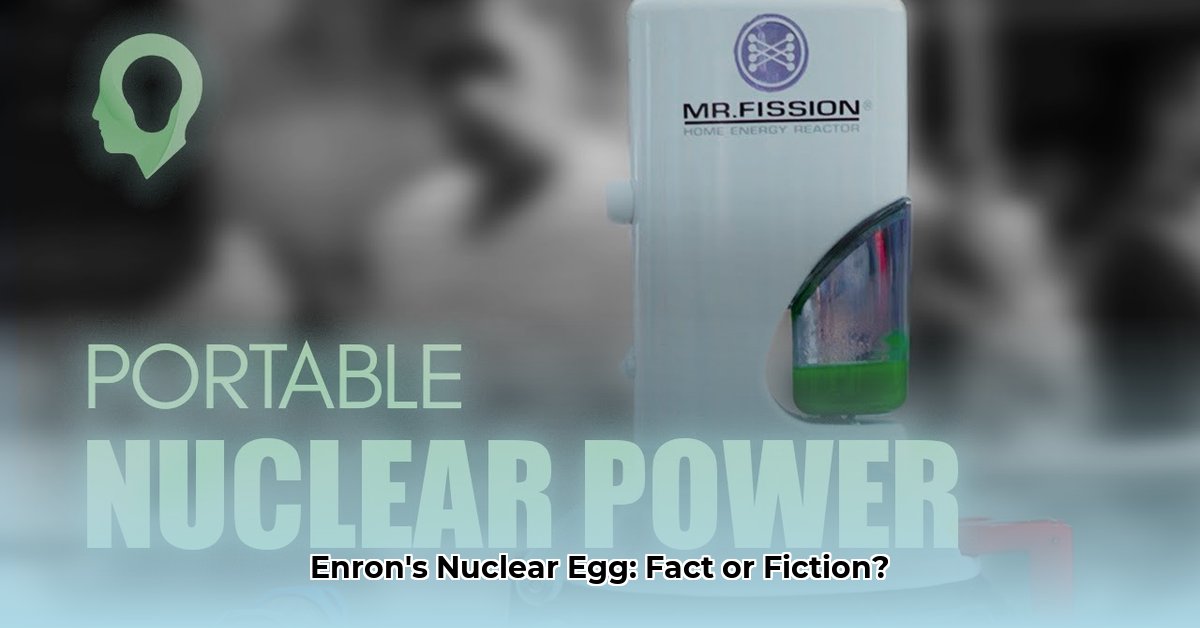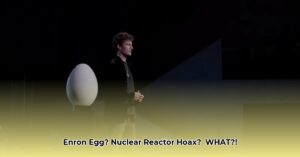The Enron Egg: A Nuclear-Powered Hoax?
The “Enron Egg” – a portable nuclear reactor promising clean energy for everyone – made waves online. Too good to be true? It was. This article unpacks the Enron Egg hoax, exploring its origins, public reaction, and the deeper societal anxieties it reveals.
Cracking the Shell: Inside the Enron Egg Hoax
The Enron Egg “hatched” online in early January 2025. A fake website (enron.com, ironically) and a promotional video featuring a fictitious CEO, Connor Gaydos, advertised this “revolutionary” device. Promising to power homes for a decade, it was touted as the “Tesla of nuclear power.” But the Enron name, synonymous with corporate scandal, cast a long shadow.
Why Enron? Satire at Its Finest
The “Enron” branding wasn’t accidental. It’s a satirical jab at the company’s history of deception. The tagline, “Nuclear you can trust,” drips with irony, highlighting public distrust of both Enron and nuclear technology.
Public Reaction: A Mix of Intrigue and Skepticism
Initially, the Enron Egg fooled some. The concept of portable nuclear power is intriguing. However, online skepticism quickly emerged. Major news outlets (like Forbes, The New York Times, and USA Today) debunked the hoax, shifting the focus to online misinformation.
Beyond the Yolk: Deeper Messages and Implications
The Enron Egg hoax, though short-lived, served a purpose: it highlighted how easily misinformation spreads online and demonstrated satire’s power. It also sparked discussions about our technological desires and trust in corporations. Would you entrust Enron with nuclear technology? Probably not.
Could a Portable Nuclear Reactor Ever Exist?
While the Enron Egg was fake, Small Modular Reactors (SMRs) are a legitimate research area. SMRs are much smaller than traditional nuclear plants, offering localized energy solutions. However, challenges regarding safety, waste disposal, and public perception remain, making widespread use uncertain as of 2025. The Enron Egg and SMRs are distinct—one a hoax, the other a potential (though complex) energy solution.
Critical Thinking in the Digital Age
The Enron Egg underscores the need for critical thinking. We’re bombarded with information, making it crucial to assess credibility. Questions to ask include:
- Who is the source?
- What’s their motivation?
- Is it too good to be true?
- What do other sources say?
By thinking critically, we can navigate the information landscape and avoid being “scrambled” by misinformation.
Unpacking the Motivation: Why the Enron Egg?
Connor Gaydos, co-founder of the “Birds Aren’t Real” movement, masterminded the Enron Egg. His history of creating viral hoaxes suggests a deliberate strategy to capture public attention. The Enron Egg’s satirical purpose is likely multi-layered:
- Mocking the original Enron scandal.
- Satirizing blind faith in technology.
- Playing on energy anxieties.
The hoax’s success stems from its professional website and video, mimicking corporate announcements. The presentation was so convincing that many were initially fooled. While disclaimers revealed the joke, it continued to spread, sparking confusion and amusement across social media.
While SMRs are a genuine research area, they are far from the Enron Egg’s promise of a simple, affordable home nuclear reactor. The idea of plugging a nuclear reactor into a wall outlet remains science fiction.
The Enron Egg is a cautionary tale about critical thinking online. It emphasizes skepticism, especially with extraordinary claims. In an era of evolving technology and misinformation, discerning fact from fiction is crucial.
The Psychology of Belief and Technological Anxiety
The Enron Egg’s intriguing aspect is its commentary on belief. Our susceptibility to such hoaxes probably stems from our desire for simple solutions to complex problems (like the energy crisis), fascination with technology, and the social media echo chamber effect. It also taps into our anxieties about rapidly advancing technology. The Enron Egg embodies this ambivalence—alluring yet alarming.
Sparking Deeper Conversations
While a parody, the Enron Egg raises legitimate questions about energy’s future:
- What role will new technologies play?
- What are the potential risks and benefits?
- How can we ensure responsible development?
This demonstrates how a simple hoax can spark meaningful dialogue.
The Power of Satire
The Enron Egg reminds us of satire’s power to expose societal vulnerabilities. By presenting an absurd scenario, the hoax forces us to confront our assumptions, biases, and encourage thoughtful dialogue.
Who Hatched the Enron Egg?
The Enron Egg isn’t just a hoax; it’s targeted satire from Connor Gaydos and the “Birds Aren’t Real” team. They use absurdity to highlight serious issues, targeting corporate greed and our complex relationship with energy. The “Nuclear you can trust” slogan, given Enron’s history, is pure irony.
Gaydos, impersonating an Enron CEO, delivered pronouncements about the Egg’s capabilities, blurring reality and satire. The campaign began in early January 2025, spreading rapidly across social media. Major news outlets eventually exposed the hoax, but it had already sparked important conversations.
The Enron Egg, while fake, achieved something real: it demonstrated how misinformation spreads, how we’re swayed by marketing, and perhaps our willingness to believe in impossible solutions. It emphasizes the importance of critical thinking and healthy skepticism. It reminds us of the impact of corporate scandals and taps into anxieties about corporate power and the need for transparency. The hoax reflects our hopes and fears about the future.
Going Viral: How the Enron Egg Spread
The Enron Egg’s viral success wasn’t accidental. It was a carefully crafted blend of a preposterous product, the infamous Enron name, dark humor, and strategic use of social media—targeted advertising and memetic principles likely played significant roles. Traditional news outlets, in debunking the hoax, ironically increased its visibility.
The satire targeted several societal aspects:
- Corporate Greed: The Enron name highlighted unchecked ambition.
- Energy Anxiety: The Egg tapped into fears about energy security.
- Misinformation: The hoax demonstrated how easily false information spreads.
- Blind Faith in Technology: The Egg revealed our willingness to believe in seemingly impossible technological solutions.
The Enron Egg, while fake, sparked important conversations about misinformation and satire. It’s a reminder of the importance of media literacy and critical thinking, underscoring online culture’s growing influence. Even in internet absurdity, valuable lessons can be learned.







